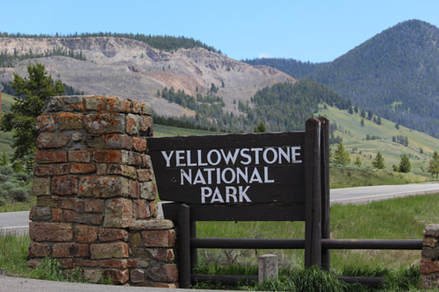visiting national and state parks with your pets
 Summer visitation at many national and state parks is in full swing. These places remain popular destinations for individuals and families. I recently returned from the Yellowstone National Park area, one of my favorite places in the U.S. Each year nearly four million people trek by automobile, motorcycle, bicycle, and RV through Yellowstone; many also hike the trails and visit the famous geyser basins, such as Norris and Old Faithful.
Summer visitation at many national and state parks is in full swing. These places remain popular destinations for individuals and families. I recently returned from the Yellowstone National Park area, one of my favorite places in the U.S. Each year nearly four million people trek by automobile, motorcycle, bicycle, and RV through Yellowstone; many also hike the trails and visit the famous geyser basins, such as Norris and Old Faithful.There are rules about pets when it comes to taking them in national, as well as state parks. Before embarking upon such a journey with your furry friend, review the pet policies.
National Parks and Pets
Pets are welcome in America’s national parks. However, there are some rules that travelers with pets should be aware of. Those include:Service animals should be clearly marked that they are working animals.Pets are prohibited in the backcountry of most western national parks, including trails, and in Yellowstone, pets are not allowed on boardwalks around the thermal areas.Do not leave your pet unattended or tied to an object – ‘unattended’ includes in the vehicle.Clean up after your pet.Always keep your pet under control, on a leash or in a crate.You may have your pet in the ‘front country’ of the park, including campgrounds, in parking areas, and within 100 feet of roadways.
In addition to providing a wonderful respite for humans, America’s national parks are home for many species of wildlife; in Yellowstone and Grand Teton, for example, these include bears and bison. Pets running loose or hiking with owners in the backcountry can harm wildlife – or be harmed themselves. Therefore, the National Park Service, recognizing that many people travel with pets, accommodates our four-footed companions in certain areas while prohibiting them in others, for the safety of both pets and wildlife.
Speaking of accommodations, are there places inside the parks that allow people to stay with their pets other than the campgrounds? In some cases, yes. Hotel accommodations in Yellowstone, for example, are not pet-friendly, but a few of the cabin facilities inside the park do allow pets. Additionally, just outside the national parks’ boundaries are gateway communities in which many hotels can be found, and many of those are pet-friendly. Prepare in advance to review the communities’ lodging options and investigate ahead of time whether pets are welcome. Look and book in advance! There are many great resources for finding pet-friendly lodging, including GoPetFriendly.com and BringFido.com. Rover.com provides a listing of pet sitters in various communities, which can be a good option if you’re staying in a town near a national park and you want to take a day-trip for hikes, horseback riding or other activities that don’t accommodate pets.
Although the national parks have similar guidelines because they are federal entities, different parks may have different pet policies. To learn about the regulations in the park you’d like to visit, log onto the National Park Service’s website at www.nps.gov, find the park you’re interested in, and review that park’s pet particulars. You can also visit this Travel Channel site to read an article about national parks that are pet-friendly and those not as much so: https://www.travelchannel.com/interests/national-parks/photos/exploring-our-national-dog-parks.
State Parks and Pets
In June, I spent a week in Oregon visiting family and driving along the Pacific Coast Highway. I was pleasantly surprised to find two things: (1) many Oregon state parks have no (or minimal) entrance fees; and (2) pets are welcome at most Oregon state parks and beaches, including some trails. Therefore, I visited many of these places with my traveling companion, Jeremiah the Shih Tzu.
All states differ in their pet policies when it comes to visiting state parks. Wyoming, where I live, for example, allows dogs to be on leashes up to 10 feet in length (many other states limit the length to six feet). A person is also able to leave a pet unattended for an hour (although I personally would not do so).
So, know before you go! Visit the parks’ websites for the state (or national) park you want to visit before taking your pet on the trip.
May your adventures with your furry friend be enjoyable – happy traveling!

Published on July 11, 2018 07:39
No comments have been added yet.



